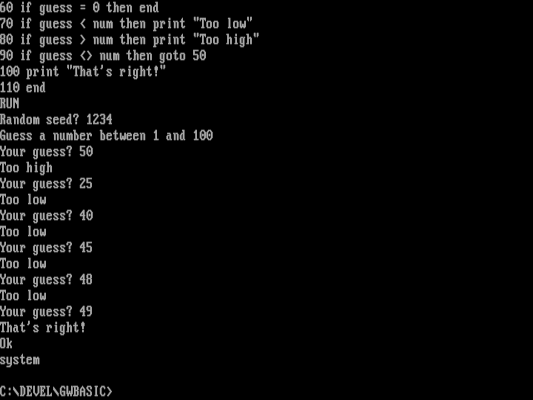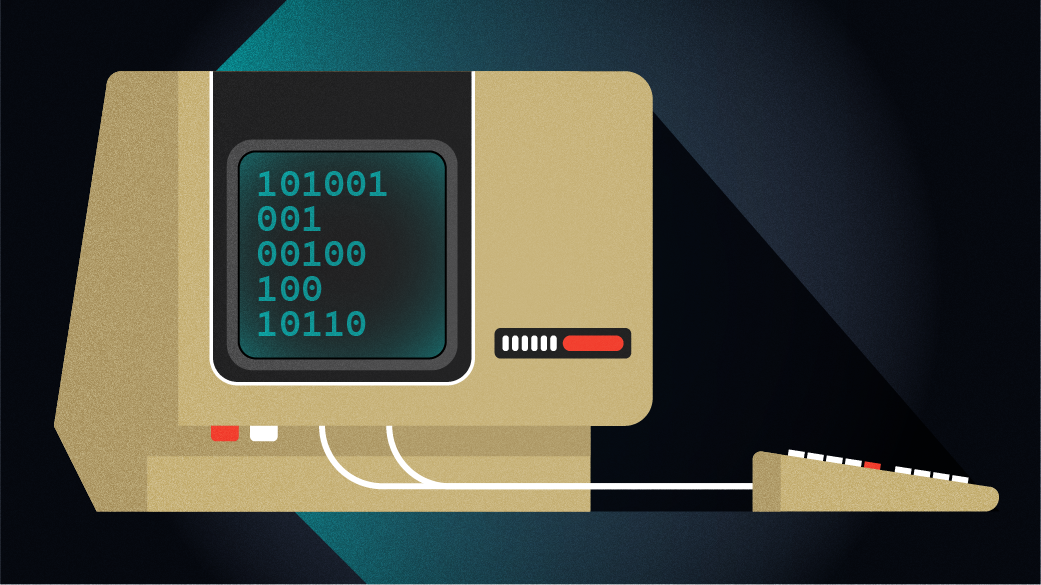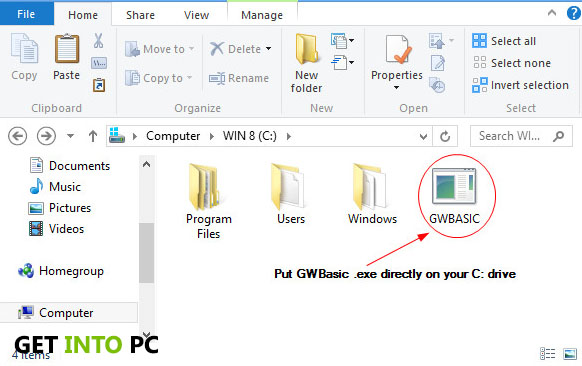

- GW BASIC PROGRAMMING LANGUAGE HOW TO
- GW BASIC PROGRAMMING LANGUAGE MANUAL
- GW BASIC PROGRAMMING LANGUAGE SOFTWARE
Berkeley, Calif.: Osborne/McGraw Hill, 1983. Reading, Mass.: Addison-Wesley Publishing Co., 1978.Įttlin, Walter A. Rochelle Park, N.J.: Hayden Book Company, 1978.ĭwyer, Thomas A. New York: Wiley Interscience, 1978.Ĭoan, James. The following texts may be useful for those who wish to learn BASIC programming:Īlbrecht, Robert L., LeRoy Finkel, and Jerry Brown.
GW BASIC PROGRAMMING LANGUAGE MANUAL
This manual is a guide to the use of the GW-BASIC Interpreter: it makes no attempt to teach the BASIC programming language. The Glossary defines words and phrases commonly used in GW-BASIC and data processing.
GW BASIC PROGRAMMING LANGUAGE HOW TO
It also explains the unique properties of the ten re-definable function keys and of other keys and keystroke combinations.Ĭhapter 5, "Creating and Using Files," tells you how to create files and to use the diskette input/output (I/O) procedures.Ĭhapter 6, "Constants, Variables, Expressions, and Operators," defines the elements of GW-BASIC and describes how you will use them.Īppendix A, "Error Codes and Messages," is a summary of all the error codes and error messages that you might encounter while using GW-BASIC.Īppendix B, "Mathematical Functions," describes how to calculate certain mathematical functions not intrinsic to GW-BASIC.Īppendix C, "ASCII Character Codes," lists the ASCII character codes recognized by GW-BASIC.Īppendix D, "Assembly Language (Machine Code) Subroutines," shows how to include assembly language subroutines with GW-BASIC.Īppendix E, "Converting BASIC Programs to GW-BASIC," provides pointers on converting programs written in BASIC to GW-BASIC.Īppendix F, "Communications," describes the GW-BASIC statements required to support RS-232 asynchronous communications with other computers and peripheral devices.Īppendix G, "Hexadecimal Equivalents," lists decimal and binary equivalents to hexadecimal values.Īppendix H, "Key Scan Codes," lists and illustrates the key scan code values used in GW-BASIC.Īppendix I, "Characters Recognized by GW-BASIC," describes the GW-BASIC character set. The GW-BASIC User's Guide is divided into six chapters, nine appendixes, and a glossary:Ĭhapter 1, "Welcome to GW-BASIC," describes this manual.Ĭhapter 2, "Getting Started with GW-BASIC," is an elementary guideline on how to begin programming.Ĭhapter 3, "Reviewing and Practicing GW-BASIC," lets you use the principles of GW-BASIC explained in Chapter 2.Ĭhapter 4, "The GW-BASIC Screen Editor," discusses editing commands that can be used when inputting or modifying a GW-BASIC program. Used for keys, key sequences, and acronyms.īrackets surround optional command-line elements.

Used for sample command lines, program code and examples, and sample sessions. Used for filenames, variables, and placeholders that represent the type of text to be entered by the user. Used for commands, options, switches, and literal portions of syntax that must appear exactly as shown. Throughout this manual, the following conventions are used to distinguish elements of text: For more information on MS-DOS, refer to the Microsoft MS-DOS 3.2 User's Guide and User's Reference. This manual is written for the user familiar with the MS-DOS operating system. Be sure to make a working copy of the diskette before you proceed.

Your GW-BASIC files will be on the MS-DOS diskette located at the back of the MS-DOS User's Reference. This version of GW-BASIC requires MS-DOS version 3.2 or later. Section 1.5 lists resources that will teach you how to program. This guide is designed to help you use the GW-BASIC Interpreter with the MS-DOS® operating system.
GW BASIC PROGRAMMING LANGUAGE SOFTWARE
You will also be able to modify existing software that is written in GW-BASIC. With GW-BASIC you will be able to write both simple and complex programs to run on your computer. Microsoft® GW-BASIC® is a simple, easy-to-learn, easy-to-use computer programming language with English-like statements and mathematical notations. Welcome to GW-BASIC Notational Conventions


 0 kommentar(er)
0 kommentar(er)
